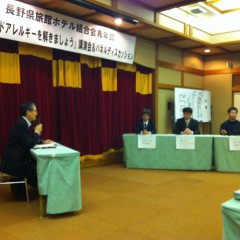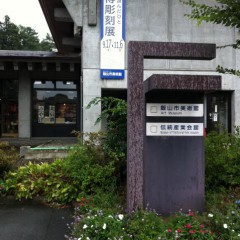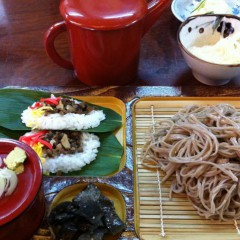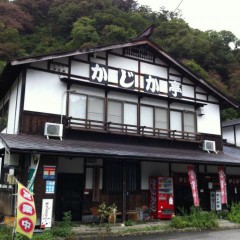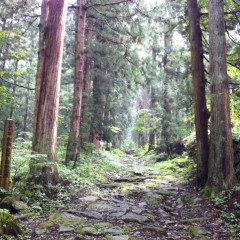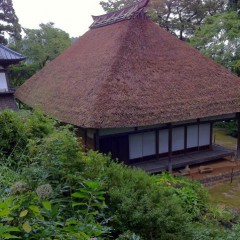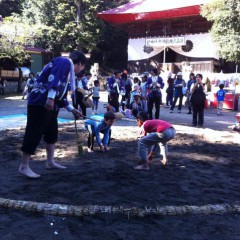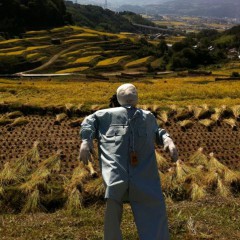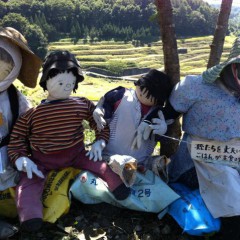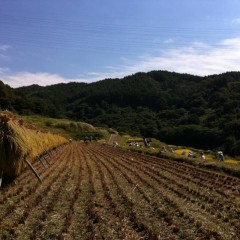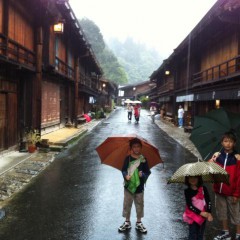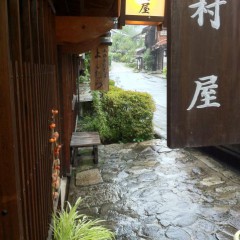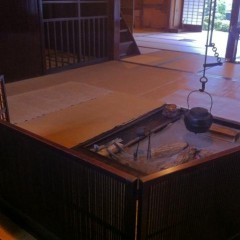
Wakihonjin's hearth 脇本陣の囲炉裏
妻籠に住んでいる皆様は色々と犠牲して、大変でしょう。アイスを打っていろお店は玄関にプラスチックのアイスクリームコーンの看板を設置したら、お客さんの目を引いて、良い商売になるでしょう。しかし、お店の皆がそうやって派手な看板を置けば、江戸時代の街並みが崩れる。そのお互いの「遠慮」のお蔭で、我々妻籠に観光しにくる皆が本物の宿場を楽しめる訳。
色んな悩みはあるでしょう。どこまで「本物」をすべきかと。道はアスファルトです。「石畳にしたら?」と商工会の方に言ってみたら「もともとは石じゃなくて、土だった。しかし、今は土に戻したら夏が埃だらけ、雨が降れば泥になっちゃう;ここで生活をしている皆を考えて、取り敢えずはアスファルト」だと。
まあ、そんな生活の為の妥協は多少あるかもしれないけど、むしろその方が良いです。妻籠は歴史資料館ではなくて、本物の人達が本当に住んでいる。その生活の匂いがあるからこそ、妻籠は魅力的だと思います。その中で、代表的な3か所を紹介したいと思います。
脇本陣奥谷
資料館となっています。が、ガイドがツアーしてくれます。
妻籠に行けば、このツアーに参加するの必須です。
良いですか?必須です。
まずは皆が囲炉裏の周りに触ります。ここから「江戸時代の生活」ストーリーが始まります。
私が座ったところが偶々宿主の位地でした。その人専用な足置き板があって、「あっ、一番偉い人の足が囲炉裏の火で温まれるように!」
妻が座ったところは畳じゃなくて、ござが木の上に引いただけでした。「嫁さんの場所。我慢すれば、いずれかは畳の方に上がる」と。
一つ、一つは意味がある。
庭の気も一つ一つ意味がある。
館内の飾り、部屋、トイレも(一度も使われていないトイレ!)、一つ一つ意味がある。
ここのガイド初孫を愛しているように感じて、親切に説明してくれる。
必須です。
http://tumago.jp/highlight/wakihonjin.html
衣料品店「Obarajun」
「これは和服じゃない!俺のオリジナルだ!」と、日本生まれ、日本育ち、どう見ても日本人Obarajunさんが作品を一生懸命説明する。和服じゃないかもしれないけど和の人の作った服なので「和」の影響は見えます。
妻籠はどの家でも「後継ぎ」はきっと難しいでしょう。Obarajunさんはその難しさを逆に抱いて、自分のファションをやりだした。思い切って。
この伝統的な街に最新的なファション。
ただ、和服と言わないで。
www.takenet.or.jp/~obarajun
旅館藤乙
江戸時代は家の部屋と部屋の間は壁じゃなくて、ふすま;廊下が狭くて(低くて!);冬は寒い;色々と不便でした。一泊ぐらい、その不便さを体験してみませんか?私達は旅館藤乙に泊まりました。建物と言え、庭と言え、お料理と言え、そして一番はオーナーと娘の笑顔。その不便さが忘れちゃう。
(大変お世話になりました!有難うございました!)
www.tsumago-fujioto.jp
The people making a living in Tsumago have to make a lot of sacrifices. A shop that sells ice cream, for example, would attract more customers if they put a giant ice cream cone sign in front of their store. But if all the owners put up gaudy signs in their storefronts, Tsumago's Edo-period ambience would be destroyed. The sacrifices have paid off though -- visitors are treated to an as authentic as possible Edo post town experience.
'Authenticity' comes with challenges. I told my buddy at the local Chamber of Commerce that the main road would look better if it were cobblestones instead of asphalt. He told me the road was originally dirt, not cobblestone. But a dirt road now would mean dust in dry times and mud when it rains, not something the people living there now would appreciate.
But that's what makes Tsumago different from being just a museum -- people live and work here. I'd like to highlight 3 such places that make Tsumago so rewarding to visit.
Waki-Honjin Okuya
Originally the place charged with accepting overflow guests that the main inn ('Honjin') couldn't handle, Okuya is now set up as a museum. But not just any old museum where you walk through, say 'Wow!', and leave. Take the time to have a guide walk you through (tours available in English, so no excuses!). First, you will all sit around the hearth. The history lesson begins there. "You, sitting at the head, put your feet out and rest them on that log. Nice and warm, right? That's where the master of the house sits." Every little detail, from where people sit to what plants are grown in the garden and where, has a reason behind it. Secret chambers, a toilet that has never been used, etc., etc. So many stories. So worth the time. The enthusiastic guides clearly love Tsumago, and you will, too.
http://tumago.jp/english/index.html
Obarajun
"These clothes aren't Japanese clothes. I made them, and I'm Japanese, but these aren't Japanese clothes." Obarajun is adamant about his original-design clothes in his shop on the main road in the center of Tsumago. All the residences here must have concerns about the difficulty of the next generation continuing the tradition. Obarajun has embraced the difficulty with his own, unique flair, his forward fashion a funky fit for traditional Tsumago.
www.takenet.or.jp/~obarajun
Ryokan Fujioto
Paper walls? Shoulder-width corridors? Why would anyone pay to stay at such a place? Well, to experience how travellers stayed back in the 1800's. Fujioto's beautiful gardens, detailed architecture, delicious local cuisine all serve to provide a window onto how life was in yesteryear. And the owner and his daughter provide the right touch with their hospitality and smiles.
http://www.tsumago-fujioto.jp/tomarie.html
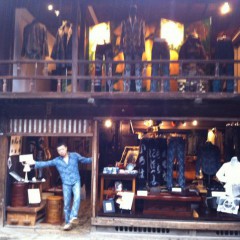
Obarajun
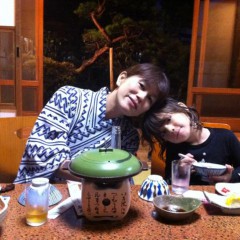
Dinner at Fujioto
